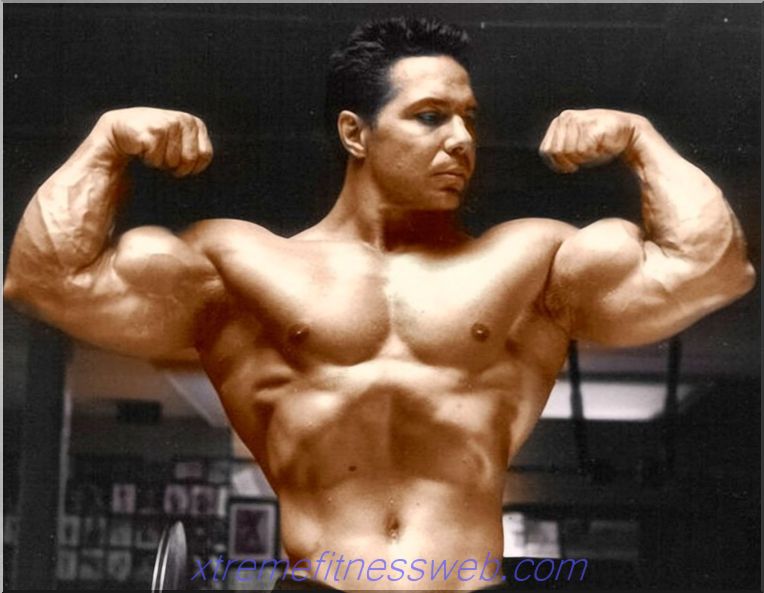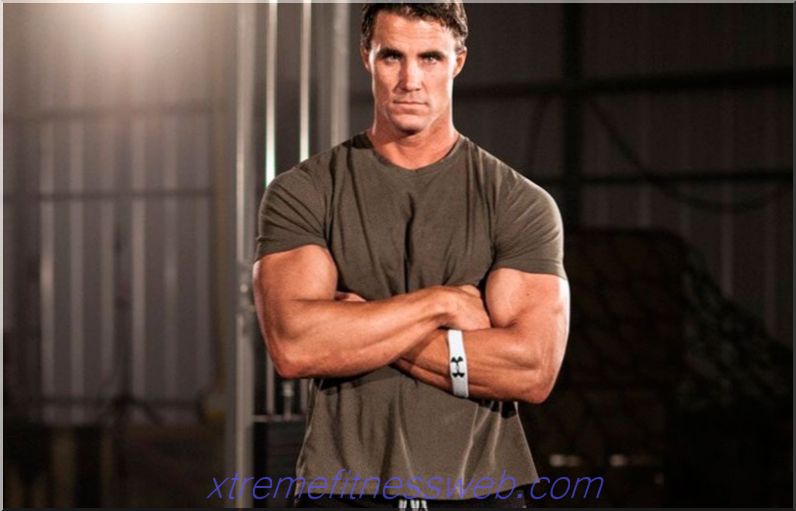- Benefits and Benefits
- What muscles work
- Types of dumbbell scrubs
- Exercise technique
- Common mistakes
- Possible injuries due to scars

Shrugs with dumbbells - a general developmental exercise for performing bench press and push shvunga, push, and deadlift. In bodybuilding, it came from power sports, where the trapeze is pumped, since it is involved in the disruption of the projectile from the floor and allows you to dynamically lift almost any weight. In bodybuilding and fitness, dumbbell shrugs are chosen by those who have a development imbalance between deltas and trapezes. In nature, this is rare, but many athletes want to have powerful and pronounced trapeze, because it visually makes the torso more athletic. In fitness, exercise is given to those whose trapeze is not developed by nature, and as one of the preparatory barbell pulls. The advantage of the dumbbell option is that it is available to beginners too. They can lift shoulders with relatively low weight, and gradually strengthen the muscles.
Content
- 1 Benefits and Benefits
- 2 What muscles work
- 3 Types of dumbbell scrubs
- 3.1 Shrugs with dumbbells standing
- 3.2 Dumbbell Shrugs
- 3.3 Shrugs with dumbbells sitting
- 3.4 Shrugs lying on an incline bench
- 4 Exercise Technique
- 5 Common Mistakes
- 6 Possible injuries due to scars
Benefits and Benefits

From a biomechanical point of view, shrags develop an athlete’s ability to lift his shoulder. They help to more effectively pull the bar in the deadlift, and teach to feel the muscles so as to isolate the trapezoid in other movements. Shrags improve blood circulation in the collar zone, help get rid of spasms and headaches.
From the point of view of aesthetics - they make the shoulder girdle more massive, help to look more impressive. Against the background of broad shoulders, the waist stands out favorably, and looks good.
Dumbbell shrugs differ from barbell exercises in the following ways:
- Trajectory;
- The method of holding the projectile
The trajectory and amplitude with dumbbells are more natural for the shoulder joint than with the barbell. Athletes with shoulder injuries cannot make full-amplitude shifts with the barbell, as the shoulder joint is blocked due to pain. Dumbbells allow you to move more freely, and carry out rotation in the shoulder as much as possible. If we are talking about a healthy athlete, he will be able to raise his arms higher, bringing his elbows to a much greater height. This will help the muscle contract even more. The conclusion is simple. A large amplitude, more contraction helps to pump muscles with less weight. This is true for those who have cramps of the muscles that stabilize the body do not allow to work in this exercise with a barbell and a lot of weight. Dumbbells, due to a more natural trajectory, are better for a beginner.
Performing darts with dumbbells, the athlete can direct his palms to the sides, respectively, he will not experience pain in the hand, and problems with the elbow joint and wrist. This will help to gradually strengthen the grip without using your hands too actively. Such shrugs are suitable for beginners, people with weak grip. And since dumbbells can be chosen and medium weight, a person will not get overstretching, injury and can gradually strengthen the grip.
Shrugs with dumbbells allow you to develop neuromuscular communication and work out the technique when lifting weights to a level above pockets.
What muscles work

The main mover is the trapezius muscles. When the athlete stands straight and brings the dumbbells to a level above the pockets, both trapezius muscles are included in the work, they allow you to lift weight, and not bring the shoulders forward. The trapezius muscle lifts the shoulder and is involved in the “disruption” of weight from the floor in all strength and weightlifting exercises. Its contraction with relaxed muscles of the hand allows you to perform a scar. In fact, the exercise is insulating, with whatever projectile the athlete performs.
The round back muscles, and the entire deltoid massif, work as a stabilizer of movement. These muscles allow the shoulders not to "fall" forward. Diamond-shaped are also involved in the movement, they stabilize the pose. If a person is inclined to bend his elbows, he “earns” biceps, and a grip without using straps on heavy weight inevitably involves the muscles of the forearm. Of course, how the stabilizers work the abs and leg muscles. They allow you to minimize the buildup of the housing to a minimum.
Types of dumbbell scrubs
Types of dumbbell scrubs vary depending on the type of position taken. In short, the most trapezoid insulating shrugs are sitting, with minimal buildup of the hull. But there may be nuances caused by the structural features of the athlete. The athlete needs to make the option that is most appropriate for his goal.
Dumbbell Shrug

The classic “fast” option is to end your workout. A big plus is convenient. The athlete simply takes the weight from the rack, does not go far, performs the exercise and leaves. No need to look for a bench, drag dumbbells somewhere or do something else. Shrugs standing include all stabilizers and give some strain on the spine. Therefore, they can be done as a preparatory exercise for difficult complex lifts, and included in the training plans of beginners.
Dumbbell Shrug
This option is suitable for those who have a posterior deltoid and trapezoid lag. The slope shifts the load on the back surface of the body, and allows you to work out this part. Shrugs in a slope is an exercise from the arsenal of professional bodybuilding, but for many lovers it makes life easier due to the fact that it helps to correct posture. Movement is indispensable if in ordinary life a person spends most of his time with his shoulders “turned” forward.
Dumbbell Shrug

This technique is indispensable if the axial load on the spine is not permissible or requires reduction. It allows you to get rid of cheating, tilting and jerking the body. Shrags sitting technically more difficult, many people can’t achieve peak muscle contraction in this position, and therefore are not able to work out the muscles efficiently.
Shrugs lying on an incline bench

Exercise is like pulling a barbell or dumbbell to a belt on an incline bench. You need to lie face down, stomach on a bench and bring dumbbells up, working only with your shoulders. This version of the exercise is the least traumatic for the spine, but requires the use of only light weights, since the position of the joint is not natural for performing scars.
Exercise technique

The movement begins with the removal of dumbbells from racks or the floor. It’s important to keep your abdominal muscles taut and focus on keeping your back straight.
Further, all shrags look more or less similar:
- The athlete stands upright, looks forward, keeps the body straight, trying not to sway;
- The arms are straightened, bending at the elbows and wrists is not allowed, the shoulder blades are brought to the spine, and are rigidly locked enough so that the shoulders do not change position during the exercise;
- Then, as it were, “shrug” is performed - the athlete raises and lowers his shoulders;
- The exhalation is performed on the rise, which accompanies the peak force;
- When lowering the shoulders you need to take a breath. Thus, breathing is not natural and habitual for a person, which can lead to problems with this movement. Lowering our shoulders, we instinctively exhale. In this confusion with breathing lies the main cause of the problems;
- It is necessary to lower dumbbells smoothly, to do everything without jerking;
- In the embodiment, in a standing incline, the incline is performed due to flexion in the hip joint;
- In the variation sitting on the bench, you need to press the shoulder blades tightly to the back;
- If you want to perform the exercise while lying on an inclined bench, it is important to correctly select the backrest so that there is no “jamming” in the shoulder joints
Common mistakes

Many beginners make shrags wrong. This is quite dangerous, since the trapezius is a strong muscle, and it can literally “pull” the posture to its side and leave the person in a “skewed” state. Injuries occur, but the most common consequence of improper technique is that a person simply does not achieve the result that he aspired to by starting training.
Technical errors can be eliminated on their own by filming their equipment on video, and analyzing, or you can turn to a trainer for help who will fix all problems and put in the correct technique.
Errors in shrags can be divided into:
- Violation of the amplitude of the movement means the amplitude is too short, when the lifting height is not enough to reduce the trapezoid. Getting rid of the error is pretty simple. It is necessary to imagine with each repetition that, as if trying to reach your ears with your shoulders, this will help to carry out the movement correctly. There is another point - you need to actively perform shrags, but with less weight;
- Performing a movement with the chin pressed to the chest . A mistake allows you to stretch the neck muscles too actively, and can lead to a pinched nerve. And for most people, it does not help to achieve a result;
- Arm curl for biceps. This movement only relieves part of the load from the trapeziums, allowing the hands to move by inertia, and not helping in pumping the target muscle groups, flexion to the biceps can also cause injury to the elbow and wrist, so you need to monitor the position of the hands in the exercise;
- The tendency to overtraining trapezoid . Many athletes mistakenly believe that the smaller the muscle group, the more often it can be worked out. This is not so, because the trapezius muscles work in many exercises. All traction to the belt, deadlift, tilt traction with a barbell and dumbbells, as well as in simulators, load this muscle group. The result is one - overtrained muscles grow poorly, the athlete is approaching injury. It is advisable to combine trapeze training with work on the shoulders, or in the afternoon, when the athlete performs a strict bench press, if his focus is strength training, not bodybuilding;
- Avoidance of movement by women . Girls tend to perform a bunch of swoops on the middle delta and avoid working with the trapezius muscle. In the long run, this leads to injuries when trying to take more weight in “typical female exercises” such as Romanian deadlifts and slopes with a barbell. If a girl performs at least several approaches to the trapezoid, she is less likely to stretch the trapezius muscles when performing “movements for the buttocks”;
- Ignoring the belt if the back is weak . Using the maximum weights and equipment with a draft in the slope, it is important not to forget about the weightlifting belt. This will help not only to avoid technical errors, but also to maintain a healthy back.
Possible injuries due to scars

Since substantial weights must be used during exercise, injuries are possible. In addition, the congestion of the trapezius and deltoid muscles in everyday life cannot be ignored, due to the usual daily activity. In order to work out the trapezium in a quality manner, it is worth avoiding injuries.
First of all, the health of the joint bag of the shoulder joint, the rotator cuff of the shoulder is compromised. If the athlete performs the movement without pulling the shoulder blades to the spine and fixing his shoulders, he should pay more attention to the technique.
When using limit weights, pay attention to the technique and chew the belt. Likely damage to the spine, displacement of the vertebrae, hernia and protrusion. But these consequences are overtaken by those who have not strengthened the muscle corset enough, or are engaged, not observing the technique.
Pinched nerves and injuries of the cervical spine is a likely option for impaired shoulder movement. Elbow sprains and forearm injuries are also possible.
How to avoid injury:
- Do not put shrugs as the first exercise of the training plan, as this can lead to taking too high weights, and injury;
- Perform a complete general and articular workout. To begin with, warming up the whole body with a light aerobic load, only then - rotation in the joints;
- Do not overstate working weights; try to do without cheating in this exercise;
- Do not exceed the set training volume, do not do “extra approaches” in order to “better feel the muscle”. Excessive exercise through pain and feeling unwell is the most common cause of injuries.







